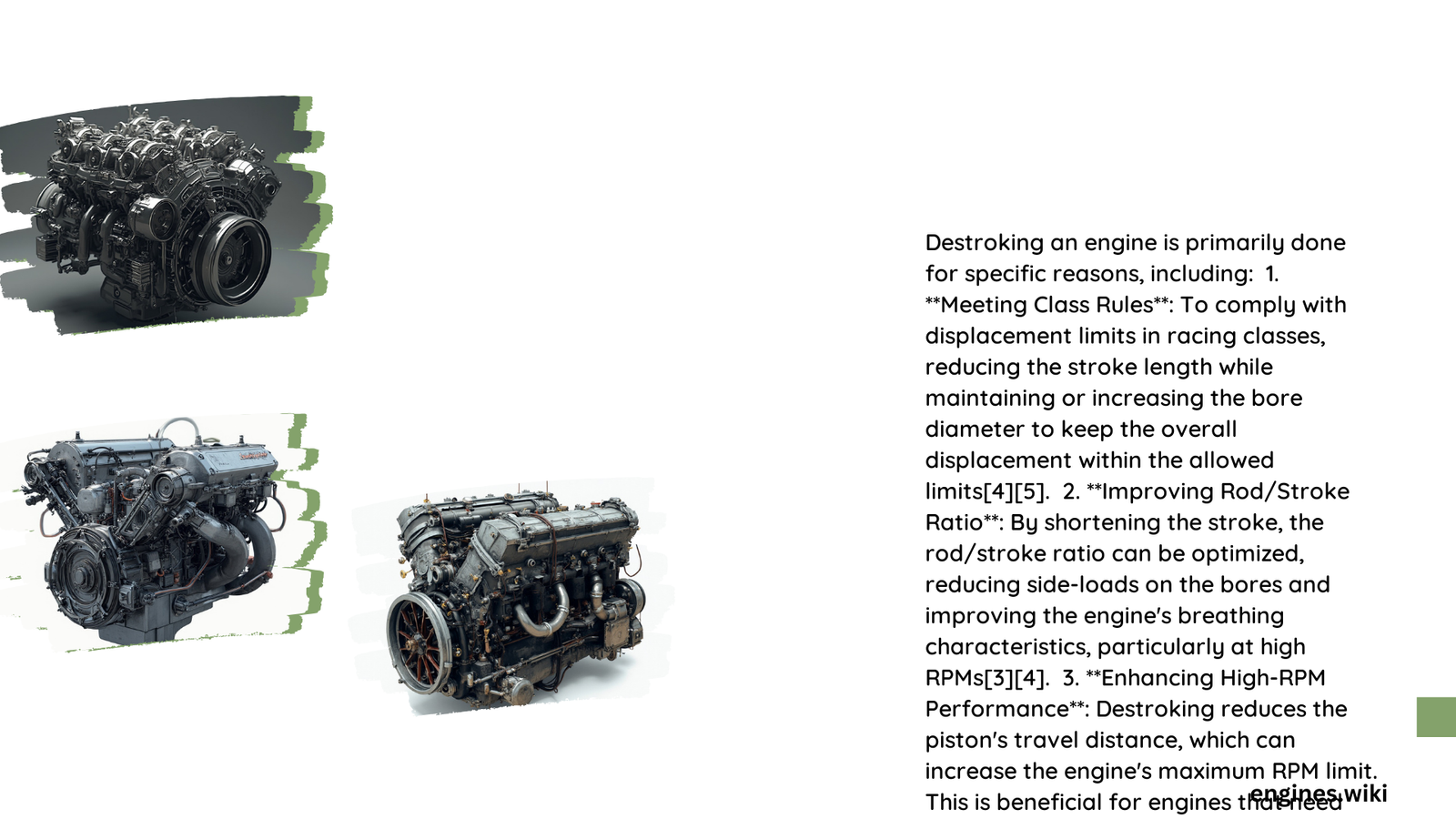Destroking an engine is a complex modification process that involves shortening the stroke of the engine’s crankshaft. This alteration reduces the overall displacement of the engine, which can have significant impacts on performance, fuel efficiency, and compliance with racing regulations. While not a common practice for everyday vehicles, destroking is often employed in specialized racing applications where specific engine displacement limits must be met. This article delves into the reasons behind destroking an engine, its effects, and the considerations involved in this intricate modification process.
What Are the Primary Reasons for Destroking an Engine?
The decision to destroke an engine is typically driven by specific performance goals or regulatory requirements. Here are the main reasons why one might consider destroking an engine:
-
Compliance with Racing Regulations: Many racing classes have strict engine displacement limits. Destroking allows teams to optimize their engines within these constraints.
-
Increased RPM Potential: A shorter stroke can reduce piston speeds, potentially allowing for higher maximum RPMs.
-
Altered Power Characteristics: Destroking can shift the engine’s power band, sometimes favoring high-RPM performance.
-
Improved Rod Ratio: By using longer connecting rods with a shorter stroke, the rod-to-stroke ratio can be optimized for better engine dynamics.
-
Customization for Specific Applications: In some cases, destroking is part of a broader engine modification strategy to achieve particular performance characteristics.
How Does Destroking Affect Engine Performance?

Destroking an engine can have several impacts on its performance:
-
Power and Torque: Generally, destroking results in a loss of overall power and torque, particularly in the lower RPM range. However, there may be some power gains at very high RPMs due to reduced piston speeds.
-
RPM Range: The engine may be capable of reaching higher RPMs, but this doesn’t necessarily translate to higher peak horsepower.
-
Throttle Response: The altered displacement and power characteristics can change the engine’s throttle response and overall feel.
-
Fuel Efficiency: There might be slight improvements in fuel economy due to potentially more complete combustion, but this is highly dependent on other factors and modifications.
What Are the Mechanical Changes Involved in Destroking?
Destroking an engine involves several mechanical modifications:
-
Crankshaft Replacement: A new crankshaft with a shorter throw is typically required.
-
Connecting Rod Adjustments: Longer connecting rods are often used to maintain the desired compression ratio and piston position.
-
Piston Modifications: New pistons may be needed to work with the altered stroke and rod length.
-
Engine Block Considerations: In some cases, the engine block may need to be modified to accommodate the new components.
-
Cylinder Head and Valve Train Adjustments: These may be necessary to optimize the engine for its new configuration.
What Are the Quantifiable Benefits of Destroking?
While specific benefits can vary widely depending on the particular engine and application, some potential quantifiable benefits include:
- Higher Maximum RPM: An increase of 500-1000 RPM or more might be achievable.
- Improved High-RPM Power: Some engines might see a 5-10% increase in power at the upper end of the RPM range.
- Slight Fuel Efficiency Improvements: In some cases, a 1-3% improvement in fuel economy might be possible, though this is highly variable.
It’s important to note that these figures are generalizations, and actual results can vary significantly based on the specific engine and modifications.
What Are the Primary Applications for Destroked Engines?
Destroked engines are most commonly found in:
- Racing Cars: Particularly in classes with strict displacement limits.
- High-Performance Street Cars: In some cases, enthusiasts may destroke engines for specific performance characteristics.
- Experimental Engines: Research and development projects may use destroking to study engine dynamics.
What Are the Costs Associated with Destroking an Engine?
Destroking an engine is a complex and often expensive process. Here’s a breakdown of potential costs:
| Component/Service | Estimated Cost Range |
|---|---|
| Custom Crankshaft | $1,000 – $3,000+ |
| Connecting Rods | $500 – $1,500+ |
| Pistons | $500 – $1,500+ |
| Machine Work | $1,000 – $3,000+ |
| Additional Parts | $500 – $2,000+ |
| Labor | $1,000 – $3,000+ |
Total costs can easily range from $5,000 to $15,000 or more, depending on the engine and the extent of modifications.
What Are the Challenges and Limitations of Destroking?
Destroking an engine comes with several challenges and potential drawbacks:
- Reduced Low-End Torque: The smaller displacement often results in less torque at lower RPMs.
- Complexity: The process requires extensive knowledge and precision to execute correctly.
- Cost: As outlined above, destroking can be a significant financial investment.
- Potential Reliability Issues: If not done correctly, destroking can introduce new stresses on engine components.
- Limited Everyday Practicality: The altered power characteristics may not be ideal for regular street driving.
Is Destroking the Right Choice for Your Engine?
Deciding whether to destroke an engine depends on several factors:
- Purpose: Is it for a specific racing class or performance goal?
- Budget: Can you afford the significant costs involved?
- Expertise: Do you have access to the necessary technical knowledge and skills?
- Performance Priorities: Are you willing to trade low-end torque for potential high-RPM gains?
- Long-Term Plans: How will this modification fit into your overall vehicle strategy?
Carefully consider these factors before deciding to destroke your engine. In many cases, other modification strategies might be more suitable for achieving your performance goals.
In conclusion, destroking an engine is a specialized modification primarily used in racing applications to meet displacement regulations while optimizing high-RPM performance. While it can offer some unique benefits, it comes with significant costs, complexities, and potential drawbacks. For most everyday drivers and even many performance enthusiasts, other engine modification strategies are likely to be more practical and beneficial.
References:
1. https://grassrootsmotorsports.com/forum/grm/what-are-the-pros-and-cons-of-destroking-an-engine/21288/page1/
2. https://www.hpacademy.com/forum/general-engine-building-discussion/show/stroker-vs-de-stroked/
3. https://www.forabodiesonly.com/mopar/threads/destroking-an-engine.279054/
